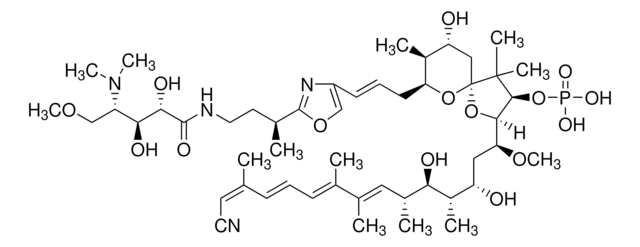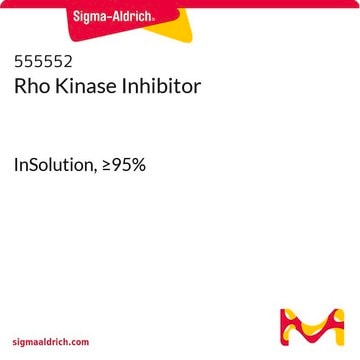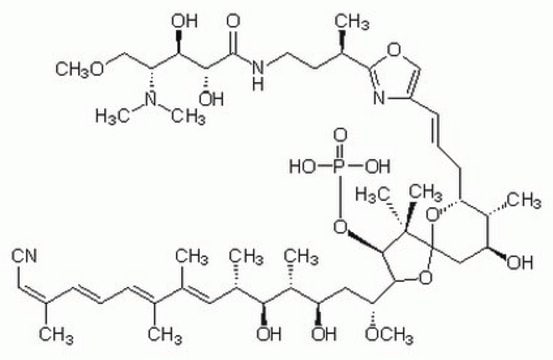555553
Rho Kinase Inhibitor III, Rockout
The Rho Kinase Inhibitor III, Rockout, also referenced under CAS 7272-84-6, controls the biological activity of Rho Kinase. This small molecule/inhibitor is primarily used for Phosphorylation & Dephosphorylation applications.
Synonym(s):
Rho Kinase Inhibitor III, Rockout, 3-(4-Pyridyl)-1H-indole
Sign Into View Organizational & Contract Pricing
All Photos(1)
About This Item
Empirical Formula (Hill Notation):
C13H10N2
CAS Number:
Molecular Weight:
194.23
UNSPSC Code:
12352200
NACRES:
NA.54
Recommended Products
Quality Level
Assay
≥98% (HPLC)
form
solid
manufacturer/tradename
Calbiochem®
storage condition
OK to freeze
protect from light
color
yellow
solubility
DMSO: 25 mg/mL
methanol: soluble
shipped in
ambient
storage temp.
2-8°C
InChI
1S/C13H10N2/c1-2-4-13-11(3-1)12(9-15-13)10-5-7-14-8-6-10/h1-9,15H
InChI key
LLJRXVHJOJRCSM-UHFFFAOYSA-N
General description
A cell-permeable indolopyridine compound that acts as a selective, reversible, and ATP-competitive inhibitor of Rho kinase activity with an IC50 of 25 µM. Does not inhibit the activation of Rho kinase nor does it affect the in vitro activities of MLCK, PKCα, and SAPK2a/p38α. Shown to be 5-fold less potent than Y-27632 (Cat. No. 688000; IC50 = ~5 µM), and display a similar specificity profile as H-89 (Cat. No. 371963). Affects cell migration, inhibits blebbing (IC50 = ~ 12 µM in M2 cells), and decreases stress fibers in Bulb 3T3 cells at 50 µM.
A cell-permeable, selective, reversible, and ATP-competitive inhibitor of Rho kinase activity (IC50 = 25 µM). Does not inhibit the activation of Rho kinase nor does it affect the in vitro activities of MLCK, PKCα, and SAPK2a/p38α. Shown to be 5-fold less potent than Y-27632 (Cat. No. 688000; IC50 ~5 µM), and display a similar specificity profile as H-89 (Cat. No. 371963). Affects cell migration, inhibits blebbing (IC50 ~12 µM in M2 cells), and decreases stress fibers in Bulb 3T3 cells at 50 µM.
Biochem/physiol Actions
Cell permeable: yes
Primary Target
ROCK
ROCK
Product competes with ATP.
Reversible: yes
Target IC50: 25 µM against ROCK
Packaging
Packaged under inert gas
Warning
Toxicity: Standard Handling (A)
Reconstitution
Following reconstitution, aliquot and freeze (-20°C). Stock solutions are stable for up to 6 months at -20°C.
Other Notes
Yarrow, J.C., et al. 2005. Chem. Biol.12, 385.
Legal Information
CALBIOCHEM is a registered trademark of Merck KGaA, Darmstadt, Germany
Storage Class Code
11 - Combustible Solids
WGK
WGK 1
Certificates of Analysis (COA)
Search for Certificates of Analysis (COA) by entering the products Lot/Batch Number. Lot and Batch Numbers can be found on a product’s label following the words ‘Lot’ or ‘Batch’.
Already Own This Product?
Find documentation for the products that you have recently purchased in the Document Library.
Elizabeth R Jerison et al.
eLife, 9 (2020-05-20)
T cells in vivo migrate primarily via undirected random walks, but it remains unresolved how these random walks generate an efficient search. Here, we use light sheet microscopy of T cells in the larval zebrafish as a model system to
Tushna Kapoor et al.
Cell reports, 34(13), 108918-108918 (2021-04-01)
Membrane curvature recruits Bin-Amphiphysin-Rvs (BAR)-domain proteins and induces local F-actin assembly, which further modifies the membrane curvature and dynamics. The downstream molecular pathway in vivo is still unclear. Here, we show that a tubular endomembrane scaffold supported by contractile actomyosin stabilizes
Ana Sousa-Ortega et al.
Nature communications, 14(1), 2804-2804 (2023-05-17)
The assembly of the embryo's primary axis is a fundamental landmark for the establishment of the vertebrate body plan. Although the morphogenetic movements directing cell convergence towards the midline have been described extensively, little is known on how gastrulating cells
Tushna Kapoor et al.
STAR protocols, 3(1), 101020-101020 (2022-01-04)
Here we describe a simple step-by-step protocol for collecting high-resolution, time-lapse images of intact Drosophila testis ex vivo for a limited period using a confocal microscope, with minimum photo-toxic damage, to monitor spermatid individualization, coiling, and release. The F-actin dynamics during
Marion Baraban et al.
Developmental cell, 58(5), 361-375 (2023-02-26)
Despite their barrier function, epithelia can locally lose their integrity to create physiological openings during morphogenesis. The mechanisms driving the formation of these epithelial breaks are only starting to be investigated. Here, we study the formation of the zebrafish nostril
Our team of scientists has experience in all areas of research including Life Science, Material Science, Chemical Synthesis, Chromatography, Analytical and many others.
Contact Technical Service







